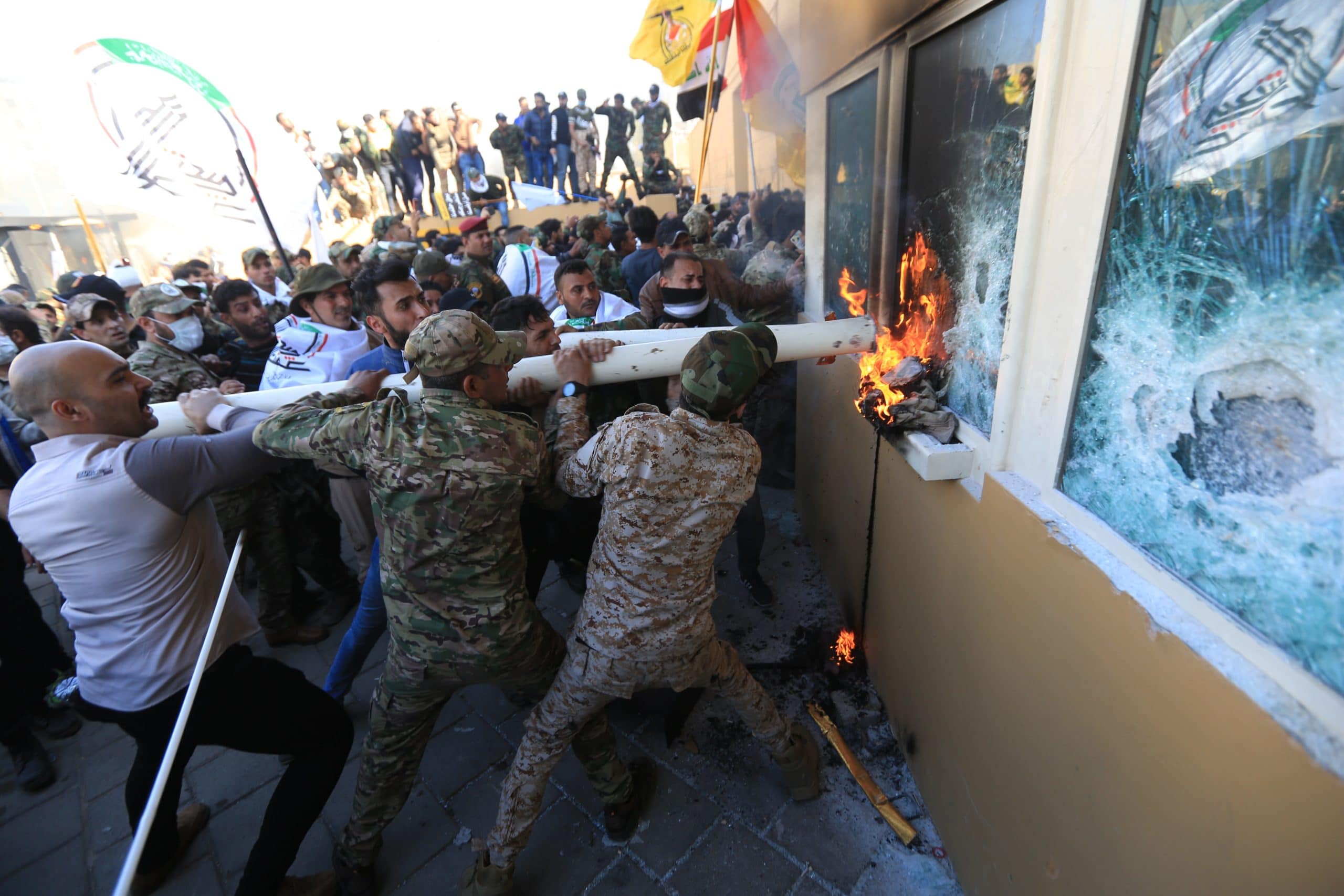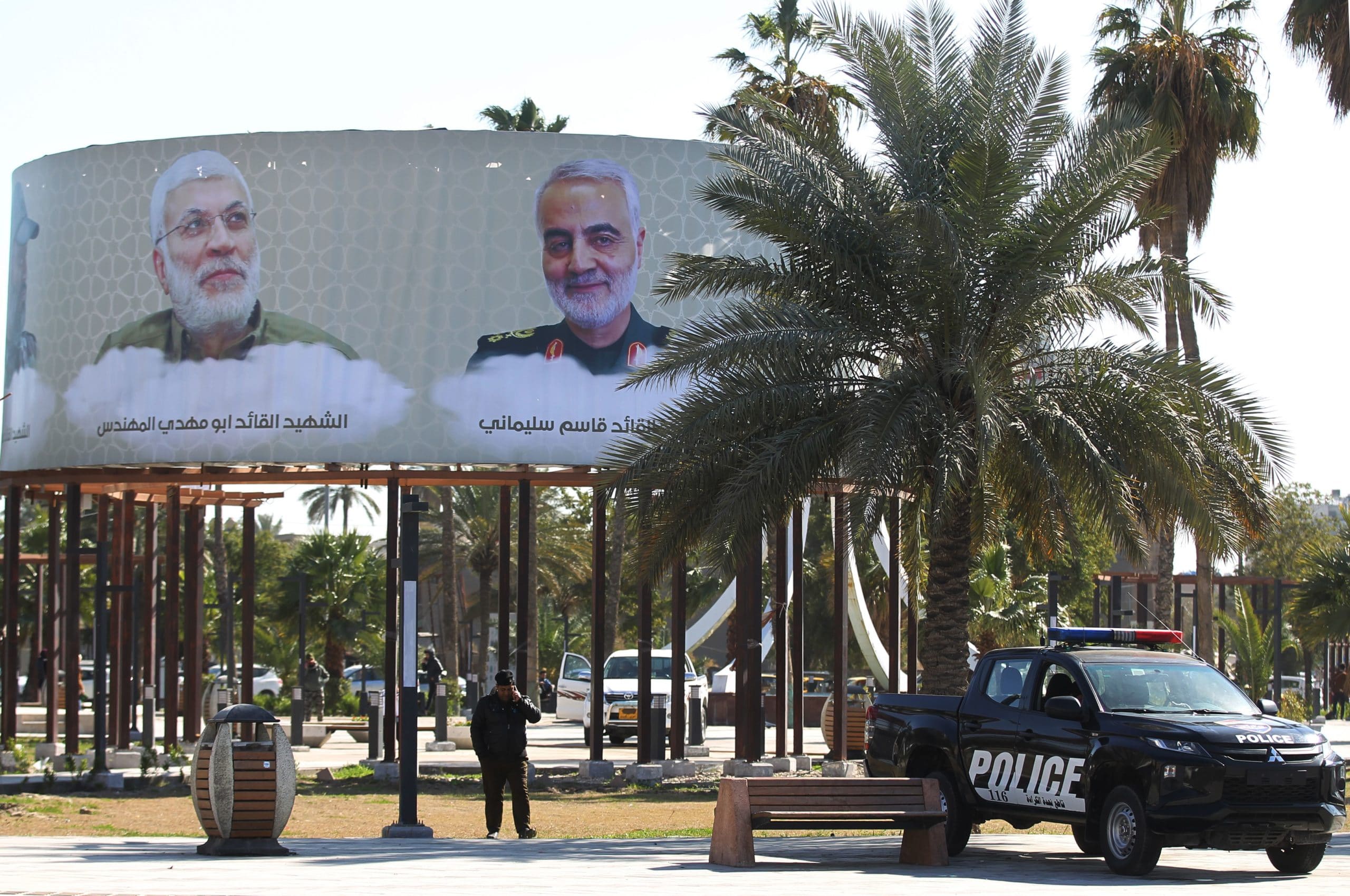January 14, 2021 | From Trump to Biden Monograph
Iraq
January 14, 2021 | From Trump to Biden Monograph
Iraq
Current Policy
In Iraq, the final two years of President Trump’s term were largely dominated by the same two challenges that shaped its first two years: battling the Islamic State of Iraq and Syria (ISIS) and constraining Iran. But whereas the war against ISIS took clear precedence from 2017 to 2018, the U.S. priority later shifted decisively toward thwarting the Iranian threat.
After ISIS lost its last stronghold in Iraq in late 2017, the administration maintained approximately 5,000 troops to stop ISIS from reconstituting. U.S. forces provided Iraqi counterparts with training, air power, intelligence, and logistics to prevent the organization’s full-blown resurgence.
Trump’s decision to withdraw from the 2015 Iran nuclear deal and re-impose sanctions set the countries on a new collision course across the Middle East, including in Iraq. After the United States moved in April 2019 to prohibit all Iranian oil exports, Tehran initiated a broad campaign of violent attacks, directly and via proxy, against U.S. interests. In Iraq, the offensive manifested in escalating rocket attacks targeting U.S. personnel by pro-Iranian militias affiliated with the state-sanctioned Popular Mobilization Forces (PMF).
The attacks intensified significantly in the wake of a mass anti-government protest movement that erupted in October 2019 among mostly Shiite youth in Baghdad and southern Iraq. The demonstrations focused not only on the government’s corruption and failure to deliver basic services and jobs, but also on its subjugation of Iraqi sovereignty to Iran. The government of Prime Minister Adel Abdul-Mahdi, in complicity with Iran and its militia proxies, brutally cracked down. Abdul-Mahdi was forced to resign, though he remained in a caretaker capacity for five months as Iraq’s political elite struggled to name a successor.
While repressing protesters, the government stood aside as rocket attacks against U.S. targets intensified.1 When an American was finally killed in late December, the United States unilaterally retaliated against Kataib Hezbollah (KH), one of Iran’s most powerful proxies.2 A series of events followed in rapid succession that brought the United States and Iran to the brink of war and U.S.-Iraqi relations to a new low. First, a PMF mob violently assaulted the U.S. Embassy. Second, a U.S. drone strike killed Qassem Soleimani, Iran’s most important general, and Abu Mahdi al-Muhandis, the de facto commander of the PMF. Third, pro-Iran elements in Iraq’s parliament passed a non-binding resolution calling for the expulsion of U.S. forces. And fourth, Iran launched a ballistic missile attack on two bases hosting U.S. troops, injuring more than 100.3
Tensions remained high throughout 2020, including a second U.S. retaliatory strike against KH.4 Nevertheless, the loss of Soleimani and Muhandis, pressure from U.S. sanctions, and the ravages of COVID-19 clearly weakened Iran’s hand in Iraq. In May, Tehran acquiesced to the rise of a new prime minister, Mustafa al-Kadhimi, an Iraqi intelligence chief with longstanding ties to Washington. The United States initiated a strategic dialogue with Kadhimi’s government in the hope of revitalizing the bilateral partnership, including hosting Kadhimi at the White House.5

Iraqi militia members attack the U.S. Embassy in Baghdad on December 31, 2019. (Photo by Murtadha Sudani/Anadolu Agency via Getty Images)
Shortly after Kadhimi’s visit, and consistent with understandings reached in the strategic dialogue, the United States announced it would reduce troops in Iraq from 5,200 to 3,000.6 More startling, in a move that caught Kadhimi by surprise, the administration threatened in late September to shutter the U.S. Embassy in Baghdad and launch massive airstrikes against Iran’s proxies if Kadhimi did not end the militia attacks.7 The warning triggered a flurry of Iraqi political activity, including with Iran, that resulted in the militias’ announcing a temporary ceasefire, conditioned on the eventual withdrawal of U.S. forces.8 After the U.S. presidential election, the administration announced it would withdraw another 500 troops, leaving a total of 2,500 U.S. forces in Iraq on the eve of President-elect Biden’s inauguration.9
Assessment
The defeat of the ISIS caliphate was one of the most significant accomplishments of Trump’s term. His subsequent decision to maintain U.S. troops in Iraq to prevent an ISIS resurgence, strengthen Iraqi security institutions, and counter Iran’s malign influence stood in stark contrast to his capricious demands to withdraw U.S. forces from Syria. It also stood in stark contrast to the decisions of his predecessor, Barack Obama, whose hasty departure from Iraq led to the rise of ISIS and enabled Iran to increase its influence.
The full-blown emergence of Trump’s maximum pressure policy against Iran created complications for U.S. policy in Iraq. In late 2018, after Trump’s withdrawal from the nuclear deal, rocket attacks by pro-Iran militias forced the United States to withdraw its diplomats from Basra, the capital of Iraq’s southern oil region near Iran’s border.10 After the U.S. decision to drive Iran’s oil exports to zero, escalating rocket attacks and U.S. demands that Abdul-Mahdi rein in the PMF only highlighted the Iraqi government’s impotence. When the United States was finally forced to take unilateral action to protect its personnel against Iran-backed attacks, including Trump’s decision to assassinate Soleimani and Muhandis, the U.S.-Iraq relationship reached its nadir, with Abdul-Mahdi and the Iraqi parliament pressing for a U.S. withdrawal and Trump threatening crushing sanctions should Iraq insist upon a hostile eviction of U.S. troops.11
Iran’s ballistic missile attack against U.S. troops in January, combined with the steady stream of militia rockets, constrained the ability of U.S. forces to fulfill their anti-ISIS mission. Force protection inevitably became a growing preoccupation, leaving U.S. soldiers increasingly hunkered down on their bases. The rocket attacks almost certainly accelerated the U.S. decision in 2020 to withdraw from at least eight bases across Iraq and consolidate the U.S. presence at two or three locations – though the U.S. military publicly attributed the move, as it did the subsequent decision to reduce troop levels to 3,000, to the increased ability of Iraqi security forces to keep ISIS at bay independently.12

A Baghdad billboard mourns the death of Iranian general Qassem Soleimani and Iraqi paramilitary commander Abu Mahdi al-Muhandis, who were killed in a U.S. drone strike on January 3, 2020. (Photo by Ahmad Al-Rubaye/AFP via Getty Images)
Though extremely high-risk, the killing of Soleimani and Muhandis, in retrospect, may have diverted the U.S.-Iraq relationship from a disastrous trajectory. Their elimination left Iran bereft of its two most important operatives in Iraq. Their sudden absence unquestionably weakened Iran’s position politically, creating space for the unexpected emergence of a Western-leaning independent like Kadhimi as prime minister, who offered the possibility of a renewed U.S.-Iraq partnership. The Trump administration wisely sought to test that proposition by initiating the U.S.-Iraq Strategic Dialogue, including welcoming Kadhimi to the White House in the middle of a presidential election campaign and global pandemic.
The administration’s sudden threat to close the U.S. Embassy and strike militia targets unless Iraq’s Western-leaning but weak premier ended militia attacks was an extremely risky gambit. If implemented, an American abandonment of Baghdad in a hail of bombs could badly harm U.S. interests by destabilizing Iraq and leaving both Iran and ISIS far less constrained. That said, the threat seemed to pay dividends, pushing the Iraqi government to undertake an unprecedented political effort with other Iraqi actors as well as Iran that resulted in the militias’ announcing a cease-fire that temporarily curtailed their attacks on U.S. interests.
Recommendations
- Reach a new bilateral understanding to keep a small U.S. military presence in Iraq. In the face of enormous pressure from Iran-backed forces, Kadhimi has publicly said that Iraq still needs U.S. military support to fight ISIS and strengthen Iraqi security forces.13 He has also condemned attacks on U.S. personnel and underscored Iraq’s responsibility to protect them. The Biden administration should take advantage of Kadhimi’s interest in resurrecting the strategic relationship. To do so, it should reach a new security understanding that reframes the U.S. role in supporting Iraq’s security and independence, including a cooperative effort to constrain the malign influence of Iran and its proxies. Importantly, the small U.S. presence in Iraq also serves as a critical enabler of continued U.S. efforts to counter ISIS and Iran in eastern Syria.
- Prioritize initiatives that bolster Iraq’s economy while undermining Iranian influence. The combination of the collapse in world oil prices, COVID-19, and massive corruption has left Iraq facing the prospect of economic collapse. There are a number of ways for the United States to support the Iraqi economy and U.S. companies while simultaneously countering Iranian influence. Several are now on the agenda with Kadhimi’s full backing and need to be executed, including large-scale deals for U.S. companies to expand Iraq’s electricity and natural gas sectors, thereby ending its heavy dependence on Iranian imports.14 Along similar lines, the United States should encourage the Gulf Arab states to invest in Iraq’s power and gas infrastructure while also moving rapidly to connect Iraq to their own electric grids. In the financial realm, the United States should support an International Monetary Fund deal to help alleviate Iraq’s massive budget shortfall, but on the condition that the government implements structural reforms of its cash-based economy that shut down major avenues of corruption – from which Iran and its proxies are among the greatest beneficiaries.
- Use U.S. influence in a discreet but focused strategy to help Kadhimi resist Iranian pressure, ensure free and fair elections, and strengthen Iraq’s peaceful protest movement. The United States retains substantial political influence in Iraq and internationally that Washington should wield to advance its goal of a sovereign and independent Iraq in close partnership with the United States. Working with its most influential foreign allies, the United States should encourage a coalition of more moderate factions in Iraq’s parliament to back Kadhimi’s economic reforms, his support for a continued U.S. military presence, and his call for early elections under a new law that breaks the stranglehold of sectarian parties and militias on Iraq’s political system. The United States and its allies should also support maximum UN monitoring and oversight of new elections to ensure the process is fair, transparent, and legitimate. Additionally, the United States needs a policy that helps Iraqi demonstrators by publicly condemning violence against them, sanctioning their abusers, and channeling their energies into an effective political movement for reform and Iraqi sovereignty.
- Keep U.S. pressure on Iran’s proxies. Working in coordination with the Iraqi government and foreign partners as much as possible, the United States should be ready to sanction a lengthy list of malign Iraqi actors, to include not just senior pro-Iranian militia figures but also high-profile political leaders and former officials implicated in large-scale corruption, human rights abuses, sanctions busting, terrorism, or undermining Iraq’s stability. Efforts should be made to locate and seize assets in foreign jurisdictions and return them to the Iraqi people. While the United States should strongly favor supporting Iraqi government efforts to counter serious threats to U.S. personnel, it should remain ready to act unilaterally if the government proves unwilling or unable to do so.
